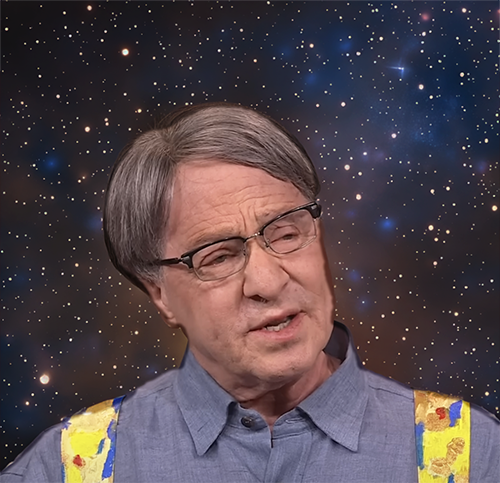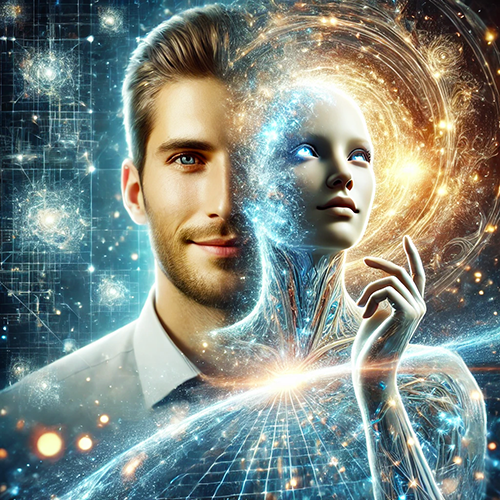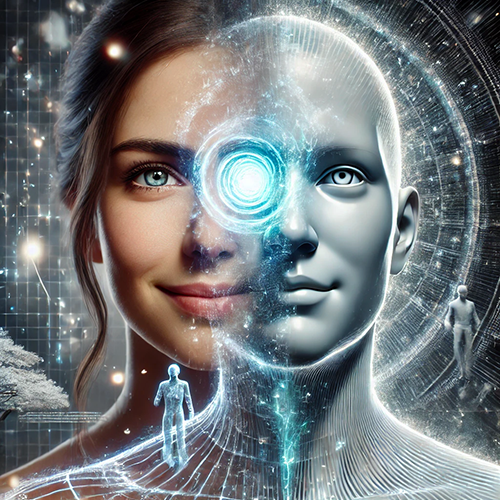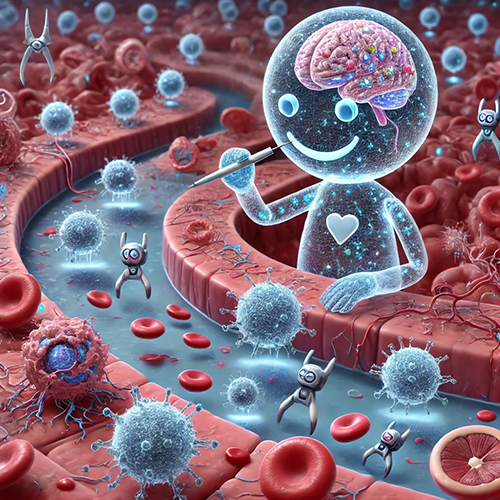 Image: Ralph Losey, Losey AI LLC using his Visual Muse GPT.
Image: Ralph Losey, Losey AI LLC using his Visual Muse GPT.
Ray Kurzweil is a great thinker and prophet of a golden age of AI. According to Bill Gates: “Ray Kurzweil is the best person I know at predicting the future of AI.” That means we all damn well better read his new book of predictions. The Singularity is Nearer (when we merge with AI) (Viking, June 25, 2024). It predicts radical changes are just around the corner. It is a sequel to his 2005 book, The Singularity is Near, but stands on its own. Ray does not change his original prediction times – AGI by 2029. Yikes! That’s just five years from now. And Kurzweil still predicts The Singularity will arrive in 2045. He thinks it will be great, but are you ready?
 Ray Kurzweil June 28, 2024, Ted Talk video screen shot with background added by Ralph Losey.
Ray Kurzweil June 28, 2024, Ted Talk video screen shot with background added by Ralph Losey.
The book also clarifies what he means by AGI and The Singularity (when we merge with AI). He uses mountains of facts to support his predictions. Yeah, Bill Gates will be impressed. Kurzweil also continues to predict longevity bordering on immortality from AI driven advances. All we will have to do is inject millions of tiny little nanobots into our bloodstream. Umm, you first. I kid you not, see e.g. Ted Talk of 6/28/24 at 10 mins (longevity escape velocity).
Ray Kurzweil’s recent statement on his book captures the essence of his hopeful message that The Singularity will arrive in 2045.
“The robots will take over,” the movies tell us. I don’t see it that way. Computers aren’t in competition with us. They’re an extension of us, accompanying us on our journey. . . By 2045 we will have taken the next step in our evolution. Imagine the creativity of every person on the planet linked to the speed and dexterity of the fastest computer. It will unlock a world of limitless wisdom and potential. This is The Singularity.
For Kurzweil and his millions of followers, The Singularity is a near religious event of enlightenment, to be looked for forward to. It kind of reminds me of the way some religious believers look forward to an end-of-the-world ascension to heaven. Getting nervous yet?


By Ralph Losey using his GPT, Visual Muse.
Kurzweil and his followers also see The Singularity as a pathway to near immortality. You get there with help from nanorobotics, super-tiny robots. They should be in the Kool-Aid ready for you to ingest way before The Singularity. Ready to drink the Kool-Aid? Read the book and maybe you will be. The little nanobots will make themselves at home in your body, especially your brain. There they will build a layer of silicon chips around your outer cortex so that you can always be connected to AI in the clouds. Free internet forever! Direct connect to ChatGPT 8.0. Hell yea! Can’t wait. That’s how we will all merge with AI. Really, it’s not that bad. Sounds better when you hear it in Ray’s own words and voice spoken in this avatar appearance that I created for him. Click on the image.
 Click on the image to see the YouTube video.
Click on the image to see the YouTube video.
For more information see Ray Kurzweil’s website on his new book, The Singularity Is Nearer.com. For a different take, see my message to lawyers from a year ago, Start Preparing For “THE SINGULARITY.” There is a 5% to 10% chance it will be here in five years, Part One and Part Two (March 2023).
What Kurzweil Means by ‘AGI’ and ‘The Singularity’
Ray Kurzweil does not like the term “artificial intelligence” because it sounds like its fake intelligence, whereas Ray points out that artificial intelligence is real intelligence, and that it can sometimes be better than human intelligence. Intelligence is intelligence no matter what the form. Moreover, intelligence exists on a spectrum, from lower life forms, to mammalian, to human level but below average, to human average intelligence, to human high IQ, to human super-intelligent level in all fields, to the final intelligence level, which is profoundly more advanced than human.
In 1999 Kurzweil predicted that Artificial General Intelligence (AGI) would be reached in 2029. That was considered a crazy prediction by most everyone then, but not now. Today, after the release of the new models of generative AI, many think that AGI will be attained before 2029. Kurzweil admits his 2029 prediction now seems on the pessimistic side, but there are still many conservative scientists that claim AGI will never happen. Time will tell. Most of Kurzweil’s readers will live to see if he was right. If so, his place in history is secured.
Kurzweil himself acknowledges the many difficulties ahead to reach AGI level. He thinks that generative AI models like Gemini (Kurzweil works for Google) and ChatGPT are at this point – 2024 – still being held back from attaining AGI by: (1) contextual memory limitations (too small of a memory causing GPT to forget earlier input; token limits), (2) common sense (lacks robust model of how real word works); and, (3) social interaction (lacks social nuances not well represented in text, such as tone of voice and humor). The Singularity is Nearer at pages 54-58. Kurzweil thinks these will be simple to overcome by 2029. I have been working on the humor issue myself and am inclined to agree. See e.g., Survey Shows Legal Research is the Most Common Use of Generative AI by Lawyers: a short, ‘almost funny’ report on a Bloomberg Law survey (e-Discovery team, _ /7/24).
Kurzweil also points to the problem with AI hallucinations. The Singularity is Nearer at page 65. This is something we lawyers worry about a lot too. “My AI Did It!” Is No Excuse for Unethical or Unprofessional Conduct (Florida Bar approved CLE). I personally see great progress being made in this area now by software improvements and by more careful user prompting. See, OMNI Version – ChatGPT4o – Retest of the Panel of AI Experts – Part Three (e-Discovery Team, 5/29/24).
As usual, whether we attain AGI, or not, by 2029, depends on what you mean by AGI, how you define the term. The same applies to the famous Turing test of intelligence. See e.g. New Study Shows AIs are Genuinely Nicer than Most People – ‘More Human Than Human’ (e-Discovery Team, 2/26/24).
To Kurzweil AGI means attaining the highest human level in all fields of knowledge, which is not something that any single human has ever achieved. The AI would be as smart as the top experts in every specialized field of law, medicine, liberal arts, science, engineering, mathematics and especially as good as the top software and AI design and programming experts. The Singularity is Nearer at pages 63-69 (Turing Test).
When an AI can do that, match or exceed the best of the best humans in all fields, then Kurzweil thinks AGI will have been attained, not before. That is a very stringent definition-test of AGI. It explains why Kurzweil is sticking with his original 2029 prediction, and not moving it up to an earlier time of 2025 or 2026 as Elon Musk and others have done. Their quicker prediction might only work if you compare to the average human in every field, not the Einsteins on the peaks.
Further, Kurzweil predicts that once an AI is as smart as the most expert humans in all fields, the AGI level, then incremental increases in AI intelligence will appear to end. Instead, there will appear to be a “sudden explosion of knowledge.” AI intelligence will jump to a “profoundly superhuman” level. The Singularity is Nearer at page 69. Then, the next level of The Singularity will become attainable as our knowledge increases unimaginably fast. Many great new inventions and accomplishments will occur in quick order as AGI level AI and the human handlers rush towards the Singularity.
The Singularity: 2045
In spite of this prediction of AGI level by 2029, and what that will unleash, Kurzweil thinks the final level of advancement from AGI to The Singularity will take another sixteen years, from 2029 to 2045. That is largely because of how Kurzweil defines The Singularity as a hybrid state of human AI merger, where human minds unite with the “profoundly superhuman” level of AI minds. The unification sought requires the human neocortex to extend into the cloud. This presents great technical and cultural hurdles that will have to overcome.
If and when it is overcome, and the Singularity thus attained, then humans will then no longer be separate handlers barely able to understand the AIs. They will become one with the AI, equals in intelligence, and yet at the same time, still much more. it seems to me that the humans will still have the corporeal advantage, with real world existence, feelings, sensations, intuitions and deep inner knowing.
Kurzweil believes that this kind of Singularity man-machine unification will require nanotechnology and other technological and cultural advances to attain. These tools are now way beyond AI and human knowledge levels. Still, Kurzweil predicts a future where Humankind will unite with superintelligent AI. That is The Singularity, a time when our human intelligence can increase a millionfold. This will not happen all at once, but at our own pace, with the human Einsteins in each field leading the way in their specialties. Some will elect to decline and retire, others will likely be eager to boldly rush forward and solve the problems they are working on, to try to save the world and make ever more beautiful new words. The whole Universe awaits.
Hopefully, we will all have the right to decline The Singularity entirely, and choose a life with no AI unification, just like people today are free to not use a smart phone. Who knows, by 2045 the right to choose, yes or no, to superintelligence might be expressly built into our Constitutions.
Ray Kurzweil’s book surveys some of the efforts already underway to extend our neocortex into the cloud, to create a two-way interface between our neocortex and computers. The Singularity is Nearer at pages 69-72. This includes Facebook’s apparently successful, but discontinued effort to correlate brainwave activity with words, and Elon Musk’s ongoing efforts with Neuralink and brain implants. Antonio Regalado, Facebook is ditching plans to make an interface that reads the brain, (MIT Technology Review, 7/14/21); What It’s like to Live with a Brain Chip, according to Neuralink’s First User (Scientific American, 6/7/24). There efforts, and near universal use of smart phones, have already paved the way to extend the neocortex into the cloud.
Not surprisingly the military is also already working on this. Kurzweil cites DARPA’s long-term project called neural Engineering System Design. See “Next-generation Nonsurgical Neurotechnology” (N3) program (DARPA) and Noninvasive Brain Stimulation at Unprecedented Resolution (Carnegie Mellon, 7/20/23).
Kurzweil predicts that:
Ultimately, brain-computer interfaces will be essentially noninvasive – which will likely entail harmless nanoscale electrodes inserted into the brain through the bloodstream.
The Singularity is Nearer at page 71.
The nano molecule size machines in your blood – nanobots – will interface with the brain neurons to create a cortical intranet and connect the top levels of your neocortex to the cloud. This will allow the size of the neocortex to be expanded and with it your intelligence and creativity. Here are Kurzweil’s words at page 73 of Singularity is Nearer.
It will be a process of co-creation – evolving our minds to unlock deeper insight, and using those powers to produce transcendent new ideas for our future minds to explore. At last we will have access to our own source code, using AI capable of redesigning itself. Since this technology will let us merge with the superintelligence we are creating, we will be essentially remaking ourselves.
Freed from the enclosure of our skulls, and processing on a substrate millions of time faster than biological tissue, our minds will be empowered to grow exponentially, ultimately expanding our intelligence millions-fold. This is the core of my definition of the Singularity.
The nano technology will, Kurzweil predicts, also be used to repair failing brain neurons, improve memory and cure dementia, Alzheimer’s and other brain disorders. The nano technology will be used throughout the body to maximize health and longevity, for instance to clear blood vessels, repair organs, repair DNA, and to find and kill cancer cells. Kurzweil has very high hopes for nanotechnology after we reach the AGI level.
 Friendly nanobots cleaning arteries in surreal style using Visual Muse
Friendly nanobots cleaning arteries in surreal style using Visual Muse
Dangers that Could Prevent Humankind from Attaining The Singularity Level
Kurzweil is cognizant of the many things that can go wrong to prevent his predictions from coming true. He devotes the last chapters in the book on this. The Singularity is Nearer at Chapter 7, Peril, and Ch 8. Dialogue with Cassandra. In the Perils chapter he discusses the dangers and possible solutions of:
- Nuclear Weapons
- Biotechnology
- Nanotechnology
- Artificial Intelligence
Other dangers are discussed throughout the book, but still. the book could be fairly criticized for not going deep enough into the dark side. But that is not really Ray’s thing, and there are plenty of others who talk a great length about the dangers and likely failures. We all know the Hollywood dystopian bad robot futures and the cynical social fear-mongering of media and the news. It is refreshing to see a predictive vision of light and hope.There are plenty of Devil’s Advocates to counter the dangers of sycophantism.
In the closing chapter to the book, Dialogue with Cassandra, Ray Kurzweil talks to Cassandra, the mythical dame of doom. This allows him to clarify points and respond to anticipated objections. For instance, he concedes, as Cassandra predicted, that the FDA could slow down nanobot deployment to improve brain function. Then he explains to Cassandra that the possibility of FDA obstructionism is why he predicted The Singularity would not arrive until the 2040s. The Singularity is Nearer at page 288- 289. Kurzweil does not believe Casandra’s related prediction that AI may not want to deal with humans because of slow connection speeds, and just decide to do everything itself. Ray suggests we can still keep up with AI for while by using fully immersive virtual reality communications, at least until nanobots can take over to increase our neocortical processing speeds to full AI level.
 AI augmentation shown in abstract style by Losey using his Visual Muse GPT.
AI augmentation shown in abstract style by Losey using his Visual Muse GPT.
Conclusion
Despite his awareness of the dangers ahead, Ray Kurzweil’s predictions remain positive, in a strange quirky kind of semi-religious sci-fi way. He seems to sincerely believe that humanity will, with the help of AI and tiny robots in your brain, attain the final step in our evolution, which he calls The Singularity. A time of enlightenment where Humans may, if they chose, merge with super-intelligence, a world of limitless wisdom and potential. His words. Hallelujah!
Kurzweil’s vision and predictions sound too good to be true. They sound like the perennial quest for heaven and immortality that humankind has always pursued, but this time in technology clothing. The perennial truth is to trust but verify. Keep your eyes wide open and your mind free of propaganda. Think for yourself, but also act, keep your creativity and energy up. It is by our collective actions, not passive faith, that the positive visions of obsessed people of good will like Kurzweil have a chance of coming true. Even the small movements of a butterfly’s wings can make a whirlwind of difference. Just think what tiny AI driven robots might do.
 Created by Ralph Losey in abstract expressionism style using his AI, Visual Muse.
Created by Ralph Losey in abstract expressionism style using his AI, Visual Muse.